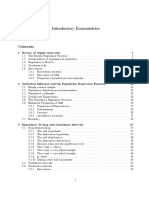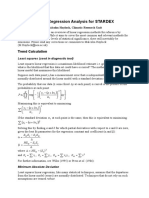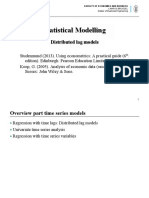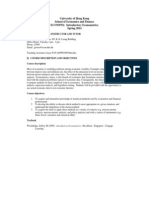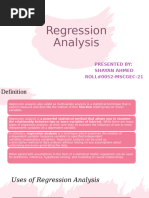Syllabus EC3303
Uploaded by
flylikethestarsSyllabus EC3303
Uploaded by
flylikethestars1
Syllabus
ECON 3303: Econometrics I
Semester 1, 2014/15
Instructor: Denis Tkachenko
Lecture Time and Room: Wednesday 2-4pm, LT11
Tutorial Room: AS4-0117
Instructors Email: ecstd@nus.edu.sg
Office: AS2 05-34
Office Hours: Thursday 2-4pm (subject to change), or by appointment
Teaching Assistants: TBA
Course Description:
Econometrics combines economic theory with mathematical and statistical tools to provide
estimates that help answering important economic questions. This course will focus on the
theoretical underpinnings, practical implementation and interpretation of results from the
multiple regression model in the cross-sectional data setting.
The main prerequisite for the class is familiarity with probability, statistics and basic calculus
(EC2303 or equivalent). For a review on probability and statistics, students can consult chapters
2 and 3 of the Stock and Watson textbook listed below.
Use of Computer: Being able to apply theoretical knowledge to real world data is one of the
focal points of this course. Students will be introduced to the Stata software package and will be
assigned homework problems that require using it. Stata has become the package of choice for
many applied economists, government bodies, and private sector firms, including banks and
consultancies. We will have access to Stata during tutorials and it is also available in the
computer labs in AS7 level 2, which are open on weekdays 9am-9pm during term time.
Text: The required textbook for the course is J .H. Stock and M.W. Watson, Introduction to
Econometrics (third international edition), Pearson, ISBN: 9781408264331. An earlier second
edition may be substituted, but the onus is on the student to verify the consistency of end-of-
chapter exercises across editions.
Two supplementary texts (not required) are Introductory Econometrics: A Modern
Approach by J .M. Wooldridge (5th edition), and Basic Econometrics by D. Gujarati and D.
Porter (5th edition).
2
Assessment: The weights for continuous assessment and exams are as follows:
Homeworks: 20%
Tutorial participation: 10%
Midterm exam: 30% (October 1
st
, 2-4pm)
Final exam: 40% (December 1
st
, 1pm)
Homework: There will be two substantial homework assignments. The assignments will have
both analytical and empirical problems. Completed homework assignments are to be handed in
on the day and at the specified time they are due. After the time specified in the deadline it will
be considered late. NO late homework will be accepted. There will be NO exceptions to this
policy, other than certified religious or medical excuses.
Group Work: The students are encouraged to collaborate on the problem sets in groups. The
minimum group size is 2, the maximum is 4. You can finish the problem sets independently if
you want. Remember, however, that group work allows you to learn from each other and
discover alternative approaches to the same problem. The key to effective group work lies in
collaborating on all assigned problems, not just splitting them among group members. Students
working on the homework together need not be from the same tutorial group, and need not keep
the same group for both assignments. Ensure that every member of the group has a copy of the
answers so that they can present at the tutorials in Weeks 7-8.
Tutorials: Tutorials are run bi-weekly starting from Week 3. Tutorials will consist of solving
analytical questions and learning to apply the theoretical concepts using Stata software. The list
of questions and Stata files will be circulated on IVLE beforehand. Tutorial attendance is
compulsory and will be graded together with students in-class presentations. Students who are
repeatedly absent from their discussion group will be brought to the attention of the Dean. While
every student will be given an opportunity to present, the onus is on the student to actively
participate in tutorial classes.
Webcasting: Lectures will be webcasted and available for repeat viewing on IVLE. Remember,
however, that webcasts are provided as an additional course feature and are not a substitute for
lecture attendance. Webcasts may suffer from technical issues that are outside the Lecturers
control, involving poor image/sound quality or failure of recording equipment, and thus relying
solely on the webcast may be a risky strategy.
Exams: There will be one midterm exam, and a cumulative final exam. Arrangements to
reschedule a midterm exam must be made at the very least 48 hours prior to the exam date and
time. There will be no make-up for the final exam.
Feedback: You are highly encouraged to provide me with feedback as we progress through the
course. You can come to my office hours, email me, leave anonymous feedback on IVLE, or
post suggestions or requests on the EC3303 forum through IVLE.
3
Email Policy: I will NOT answer any email questions pertaining to the course material. Instead,
these questions should be posted on the IVLE forum so that everyone can benefit from the
answer and have the opportunity to discuss. I usually check the forum several times a day. Please
restrict the email communication to administrative and personal matters, e.g., medical certs,
consultation appointments, tutorial absence etc.
Tentative course outline:
Date Topic Book chapters
Week 1 Introduction and Overview SW: Ch. 1
Week 2 Review of Statistics (I) SW: Ch. 2,3
Week 3 Review of Statistics (II) SW: Ch. 2,3
Week 4 Bivariate Linear Regression (I) SW: Ch. 4
Week 5 Bivariate Linear Regression (II) SW: Ch. 4,5
Week 6 Bivariate Linear Regression (III) SW: Ch. 5
Recess Week Homework 1 due Tuesday
Week 7 Midterm: October 1
st
, 2-4pm
Week 8 Multiple Regression (I) SW: Ch. 6
Week 9 Multiple Regression (II) SW: Ch. 6,7
Week 10 Multiple Regression (III) SW: Ch. 7
Week 11 Nonlinear Regression Functions SW: Ch. 8
Week 12 Assessment of Regression-based
Studies (I)
SW: Ch. 9
Week 13 Assessment of Regression-based
Studies (II) / Review
SW: Ch. 9
Reading Week Homework 2 due Tuesday
Examination Week Final: December 1
st
, 1pm
Note that the homework/exam dates and times are subject to change. It is your responsibility to
pay attention to the announcements made during the course and any changes in the final exam
timetable.
4
Learning outcomes (i.e., what you should be able to do after completing this module):
Use the statistical properties of random variables to derive and compare estimator
properties under a given set of assumptions.
Derive the OLS estimator in the linear regression context and apply the approach to other
estimation problems.
Explain the extended set of Least Squares assumptions and relate, mathematically and
intuitively, each assumption to a particular property of the OLS estimator.
Specify and estimate (using Stata) multiple regression models based on economic theory
ond OVB considerations using continuous and dummy regressors, as well as
incorporating potential nonlinear effects through polynomials, logarithms and interaction
effects.
Formulate and test research hypotheses based on single or multiple regression
coefficients, with particular attention to economic and not just statistical significance.
Evaluate the fit of estimated regression models using appropriate measures.
Critically assess the internal and external validity of existing economic studies based on
multiple regression.
You might also like
- Using Econometrics A Practical Guide 7th Edition Studenmund Solutions Manual - Available For One-Click Instant Download100% (2)Using Econometrics A Practical Guide 7th Edition Studenmund Solutions Manual - Available For One-Click Instant Download48 pages
- STAT 2066EL Final Exam Review Problems CorrectedNo ratings yetSTAT 2066EL Final Exam Review Problems Corrected6 pages
- Solutions To The Review Questions at The End of Chapter 7No ratings yetSolutions To The Review Questions at The End of Chapter 77 pages
- Econometrics 1 Cumulative Final Study GuideNo ratings yetEconometrics 1 Cumulative Final Study Guide35 pages
- Principles of Econometrics 4e Chapter 2 Solution84% (19)Principles of Econometrics 4e Chapter 2 Solution33 pages
- Supply Analysis in The Philippine Corn Industry67% (3)Supply Analysis in The Philippine Corn Industry4 pages
- A Brief Overview of The Classical Linear Regression Model: Introductory Econometrics For Finance' © Chris Brooks 2013 1No ratings yetA Brief Overview of The Classical Linear Regression Model: Introductory Econometrics For Finance' © Chris Brooks 2013 180 pages
- Linear Regression Analysis For STARDEX: Trend CalculationNo ratings yetLinear Regression Analysis For STARDEX: Trend Calculation6 pages
- Econometricsnotes2 140407141735 Phpapp01 PDFNo ratings yetEconometricsnotes2 140407141735 Phpapp01 PDF23 pages
- Stock Watson 4E Exercisesolutions Chapter12 StudentsNo ratings yetStock Watson 4E Exercisesolutions Chapter12 Students6 pages
- [Ebooks PDF] download Econometrics by Example 2nd Edition Damodar Gujarati full chapters100% (2)[Ebooks PDF] download Econometrics by Example 2nd Edition Damodar Gujarati full chapters50 pages
- Examiners' Commentary 2015: EC3115 Monetary EconomicsNo ratings yetExaminers' Commentary 2015: EC3115 Monetary Economics15 pages
- Chapter5 - Hypothesis Testing and Statistical InferenceNo ratings yetChapter5 - Hypothesis Testing and Statistical Inference50 pages
- Semester One Final Examinations 2020 ECON7350No ratings yetSemester One Final Examinations 2020 ECON735010 pages
- Instructors: Econometrics: Methods and ApplicationsNo ratings yetInstructors: Econometrics: Methods and Applications7 pages
- Chapter 8: Keynesian System (Iv) : Aggregate Supply and DemandNo ratings yetChapter 8: Keynesian System (Iv) : Aggregate Supply and Demand11 pages
- Annotated 4 Ch4 Linear Regression F2014No ratings yetAnnotated 4 Ch4 Linear Regression F201411 pages
- Forecasting 2 Forecasting. John Wiley & Sons, IncNo ratings yetForecasting 2 Forecasting. John Wiley & Sons, Inc2 pages
- Assessment Paper and Instructions To CandidatesNo ratings yetAssessment Paper and Instructions To Candidates3 pages
- Eviews 10 Tutorial: Introduction To EconometricsNo ratings yetEviews 10 Tutorial: Introduction To Econometrics43 pages
- Sharif Hossain - Econometric Analysis_ an Applied Approach to Business and Economics-Cambridge Scholars Publishing (2024)No ratings yetSharif Hossain - Econometric Analysis_ an Applied Approach to Business and Economics-Cambridge Scholars Publishing (2024)741 pages
- How Novelty and Narratives Drive The Stock Market Black Swans Animal Spirits and Scapegoats 1 Edition. Edition Nicholas Mangee100% (2)How Novelty and Narratives Drive The Stock Market Black Swans Animal Spirits and Scapegoats 1 Edition. Edition Nicholas Mangee79 pages
- Cinelli - Hazlett - 2020 - Making Sense of Sensitivity Extending Omitted Variable BiasNo ratings yetCinelli - Hazlett - 2020 - Making Sense of Sensitivity Extending Omitted Variable Bias29 pages
- Factors Affecting CO 2 Emissions in China's Agriculture Sector - A Quantile Regression (Renewable and Sustainable Energy Reviews, Vol. 94) (2018)No ratings yetFactors Affecting CO 2 Emissions in China's Agriculture Sector - A Quantile Regression (Renewable and Sustainable Energy Reviews, Vol. 94) (2018)13 pages
- (Ebook) Generalized Linear Models: with Applications in Engineering and the Sciences (Wiley Series in Probability and Statistics) by Raymond H. Myers, Douglas C. Montgomery, G. Geoffrey Vining, Timothy J. Robinson ISBN 9780470454633, 0470454636instant download100% (5)(Ebook) Generalized Linear Models: with Applications in Engineering and the Sciences (Wiley Series in Probability and Statistics) by Raymond H. Myers, Douglas C. Montgomery, G. Geoffrey Vining, Timothy J. Robinson ISBN 9780470454633, 0470454636instant download48 pages
- Introduction To Econometrics (3 Updated Edition, Global Edition)No ratings yetIntroduction To Econometrics (3 Updated Edition, Global Edition)7 pages
- Extensions Beyond Linear Regression: Topics in Data ScienceNo ratings yetExtensions Beyond Linear Regression: Topics in Data Science66 pages
- Criterion Regression 1 PDC A + (B × MP$) Regression 2 PDC A + (B × # of Pos) Regression 3 PDC A + (B × # of SS)No ratings yetCriterion Regression 1 PDC A + (B × MP$) Regression 2 PDC A + (B × # of Pos) Regression 3 PDC A + (B × # of SS)3 pages
- SPSS ANNOTATED OUTPUT Multiple RegressionNo ratings yetSPSS ANNOTATED OUTPUT Multiple Regression12 pages
- Depvar Indepvars Numlist Numlist: Arima - ARIMA, ARMAX, and Other Dynamic Regression ModelsNo ratings yetDepvar Indepvars Numlist Numlist: Arima - ARIMA, ARMAX, and Other Dynamic Regression Models24 pages
- Chapter 3 Multiple Linear Regression - We Use This OneNo ratings yetChapter 3 Multiple Linear Regression - We Use This One6 pages
- Determinants of Technical Efficiency in Maize Production-The Case of Smallholder Farmers in Dhidhessa District of Illuababora Zone, EthiopiaNo ratings yetDeterminants of Technical Efficiency in Maize Production-The Case of Smallholder Farmers in Dhidhessa District of Illuababora Zone, Ethiopia12 pages
- Public Policy Analysis Dunn Fifth Edition: WWW .Irpublicpolicy - IrNo ratings yetPublic Policy Analysis Dunn Fifth Edition: WWW .Irpublicpolicy - Ir34 pages
- MGT 6203 - Sri - M3 - Nonlinear Models v042619No ratings yetMGT 6203 - Sri - M3 - Nonlinear Models v04261919 pages
- Homoscedastic That Is, They All Have The Same Variance: Heteroscedasticity100% (1)Homoscedastic That Is, They All Have The Same Variance: Heteroscedasticity11 pages
- Using Econometrics A Practical Guide 7th Edition Studenmund Solutions Manual - Available For One-Click Instant DownloadUsing Econometrics A Practical Guide 7th Edition Studenmund Solutions Manual - Available For One-Click Instant Download
- Solutions To The Review Questions at The End of Chapter 7Solutions To The Review Questions at The End of Chapter 7
- A Brief Overview of The Classical Linear Regression Model: Introductory Econometrics For Finance' © Chris Brooks 2013 1A Brief Overview of The Classical Linear Regression Model: Introductory Econometrics For Finance' © Chris Brooks 2013 1
- Linear Regression Analysis For STARDEX: Trend CalculationLinear Regression Analysis For STARDEX: Trend Calculation
- Stock Watson 4E Exercisesolutions Chapter12 StudentsStock Watson 4E Exercisesolutions Chapter12 Students
- [Ebooks PDF] download Econometrics by Example 2nd Edition Damodar Gujarati full chapters[Ebooks PDF] download Econometrics by Example 2nd Edition Damodar Gujarati full chapters
- Examiners' Commentary 2015: EC3115 Monetary EconomicsExaminers' Commentary 2015: EC3115 Monetary Economics
- Chapter5 - Hypothesis Testing and Statistical InferenceChapter5 - Hypothesis Testing and Statistical Inference
- Instructors: Econometrics: Methods and ApplicationsInstructors: Econometrics: Methods and Applications
- Chapter 8: Keynesian System (Iv) : Aggregate Supply and DemandChapter 8: Keynesian System (Iv) : Aggregate Supply and Demand
- Sharif Hossain - Econometric Analysis_ an Applied Approach to Business and Economics-Cambridge Scholars Publishing (2024)Sharif Hossain - Econometric Analysis_ an Applied Approach to Business and Economics-Cambridge Scholars Publishing (2024)
- How Novelty and Narratives Drive The Stock Market Black Swans Animal Spirits and Scapegoats 1 Edition. Edition Nicholas MangeeHow Novelty and Narratives Drive The Stock Market Black Swans Animal Spirits and Scapegoats 1 Edition. Edition Nicholas Mangee
- Cinelli - Hazlett - 2020 - Making Sense of Sensitivity Extending Omitted Variable BiasCinelli - Hazlett - 2020 - Making Sense of Sensitivity Extending Omitted Variable Bias
- Factors Affecting CO 2 Emissions in China's Agriculture Sector - A Quantile Regression (Renewable and Sustainable Energy Reviews, Vol. 94) (2018)Factors Affecting CO 2 Emissions in China's Agriculture Sector - A Quantile Regression (Renewable and Sustainable Energy Reviews, Vol. 94) (2018)
- (Ebook) Generalized Linear Models: with Applications in Engineering and the Sciences (Wiley Series in Probability and Statistics) by Raymond H. Myers, Douglas C. Montgomery, G. Geoffrey Vining, Timothy J. Robinson ISBN 9780470454633, 0470454636instant download(Ebook) Generalized Linear Models: with Applications in Engineering and the Sciences (Wiley Series in Probability and Statistics) by Raymond H. Myers, Douglas C. Montgomery, G. Geoffrey Vining, Timothy J. Robinson ISBN 9780470454633, 0470454636instant download
- Introduction To Econometrics (3 Updated Edition, Global Edition)Introduction To Econometrics (3 Updated Edition, Global Edition)
- Extensions Beyond Linear Regression: Topics in Data ScienceExtensions Beyond Linear Regression: Topics in Data Science
- Criterion Regression 1 PDC A + (B × MP$) Regression 2 PDC A + (B × # of Pos) Regression 3 PDC A + (B × # of SS)Criterion Regression 1 PDC A + (B × MP$) Regression 2 PDC A + (B × # of Pos) Regression 3 PDC A + (B × # of SS)
- Depvar Indepvars Numlist Numlist: Arima - ARIMA, ARMAX, and Other Dynamic Regression ModelsDepvar Indepvars Numlist Numlist: Arima - ARIMA, ARMAX, and Other Dynamic Regression Models
- Chapter 3 Multiple Linear Regression - We Use This OneChapter 3 Multiple Linear Regression - We Use This One
- Determinants of Technical Efficiency in Maize Production-The Case of Smallholder Farmers in Dhidhessa District of Illuababora Zone, EthiopiaDeterminants of Technical Efficiency in Maize Production-The Case of Smallholder Farmers in Dhidhessa District of Illuababora Zone, Ethiopia
- Public Policy Analysis Dunn Fifth Edition: WWW .Irpublicpolicy - IrPublic Policy Analysis Dunn Fifth Edition: WWW .Irpublicpolicy - Ir
- Homoscedastic That Is, They All Have The Same Variance: HeteroscedasticityHomoscedastic That Is, They All Have The Same Variance: Heteroscedasticity



